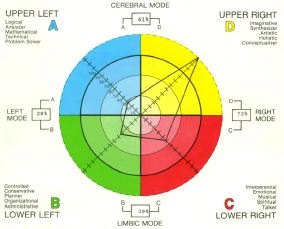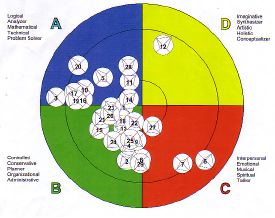Introduction
People are different from each other. Research with hundreds of thousands of people shows there are four ‘species’ of people living side-by-side on this planet. They are so different they could be painted in different colours (blue, green, red and yellow). Yet, most people think others want to be treated like they like to be treated. Without help, they simply don’t understand each other or how to get the best out each other. HBDI is the tool to build this understanding.
Issues
Do your people regularly misunderstand each other? Do you suffer from lots of disagreements? Are people bitching at each other? Do they have communication conflict? Are they talking passed each other? Do they misunderstand each other? Do they have different world-views? Are they always finding fault with each other rather than seeing their strengths? Do these same issues apply between your
Solution
Many of these issues are solved within one day when people are introduced to Herrmann’s Brain Dominance Instrument (HBDI).
Two things are needed for personal and business success: 1. self-knowledge and 2. knowledge of others. HBDI improves both. Self-knowledge is the starting point because it leads to increased self-esteem and self-improvement. Knowledge of others is important because it is the key to better communication, trust, working relationships and
Our Product
Within one day working with HBDI groups of up to 100 people have gained invaluable insights about their teammates, including: their strengths and weaknesses, how to communicate with them, how they like to be treated and how to make better use of their skills.
The introductory video:
Check out these two videos for more information:
Individual Profile
Each person gets a personalised profile (like

Individual benefits include:
- Each person understands their thinking preference under normal conditions and under stress
- Each person understands their basic need, how they like to be appreciated and what frustrates them
- Each person understands their strengths and how to play to them
- Each person understands their weaknesses and how to cover them
- Each person gains a deeper understanding of the work they do best and how they can contribute better to the organisation
- Each person ends up with a language or way of talking about deeper issues that English does not deal with well.
Team Profile
Each team gets a Group Profile (see below) showing the position of each person within the Team as a small circle. This analysis is vital for understanding the team, why the culture is as it is and how to improve it. Typically people who previously misunderstood each other become natural partners by combining their differences. People who are diagonally opposite each other often have real issues understanding each other or valuing each other, however, when they understand HBDI the penny drops as they realise that together they can be far more successful. What was previously a problem becomes a benefit.

The example (left) is of a Finance Team. It shows their heavy weighting in Blue (analysts) and Green (process). When this team first saw its profile they suddenly realised how frightening and tough and numerate they must look to the rest of the organisation that was essentially Red (Humanitarian). Because of their weighting towards Green (organising), they agreed they needed to be careful not to create systems for the sake of systems or follow procedures for the sake of procedures. Because of their weakness in Yellow (Innovation) they needed to put sufficient time into thinking about why they are producing their figures and find innovative ways to improve. The Finance Team was also very weak in Red (Humanitarian) thinking so they were not thinking carefully about the impact their figures were having on the culture of the organisation, nor how to deliver the figures in a way that was acceptable to their Red readers. Also there was no one thinking about team relationships, customer service or the affect their systems were having on people in the organisation.
Team benefits include:
- Each person understands their teammates better including: each person’s basic drivers, basic needs, how to better communicate and influence each; what frustrates each person and how to get the best out of each person by tapping into their strengths and covering their weaknesses.
- Increased trust and respect between people, and faster work flow. This happens because each person will learn how to flex their approach to match exactly the colour of their customers and colleagues; this significantly reduces the potential for interpersonal misunderstandings and mis-communications.
- A more harmonious workplace and reduced complaints from customers. This happens because each person will develop their understanding of what frustrates different types and how to anticipate this and reduce it.
- Improved communications and reduced wasted effort. This happens because each person will learn how to communicate more effectively and flex to different types.
- Better working relationships between teams. This happens because each team will understand its thinking preference and how this is seen within the organisation and outside.
- Better understanding of the customers’ needs and improve delivery. This happens because each team will identify its major customers and explore their likely thinking styles and how to approach them and communicate with them most effectively.
- The group ends up with a language or way of talking about deeper issues that English does not deal with well.
- Each person will better understand their manager and how to approach her and communicate with her most effectively.
Comparison between HBDI and MBTI
We also use Myers Briggs and have an enormous amount of respect for the instrument. Indeed when it comes to giving people a detailed description of themselves Myers Briggs is probably better than HBDI. However, in nearly all cases I would recommend HBDI because it has other major advantages over Myers Briggs. These include:
- HBDI is far more accessible to people because it is easier to use and they are almost immediately able to give close approximations of other people’s profile quite intuitively. Myers Briggs with its 16 quadrants is just too difficult for most people to be able to use unless they are experts in it. In the real world, we don’t know the profile of the person we are dealing with, therefore an instrument is not very useful unless we are able to make a close approximation on the spot.
- Herrmann is more business-friendly. With Herrmann, we are able to measure the culture and leadership profiles of a team and an organisation and show these in a powerful, graphically way that communicates issues immediately to even the most hard-nosed business manager. Myers Briggs is great for individuals but weak for groups.
- Herrmann does not put people into boxes, rather it shows that while all people use all four types of thinking they often have a preference for one (or two) types. Myers Briggs puts people in boxes; they are either Thinkers or Feelers, either Sensors or Intuitives. The world is not as black and white as this and pretending it is leads to many issues of self-limitation.
Client comments
For a list of Client Comments
Bruce Holland is our certified expert in HBDI and has worked with many large private and public sector organizations to achieve the benefits listed above.
